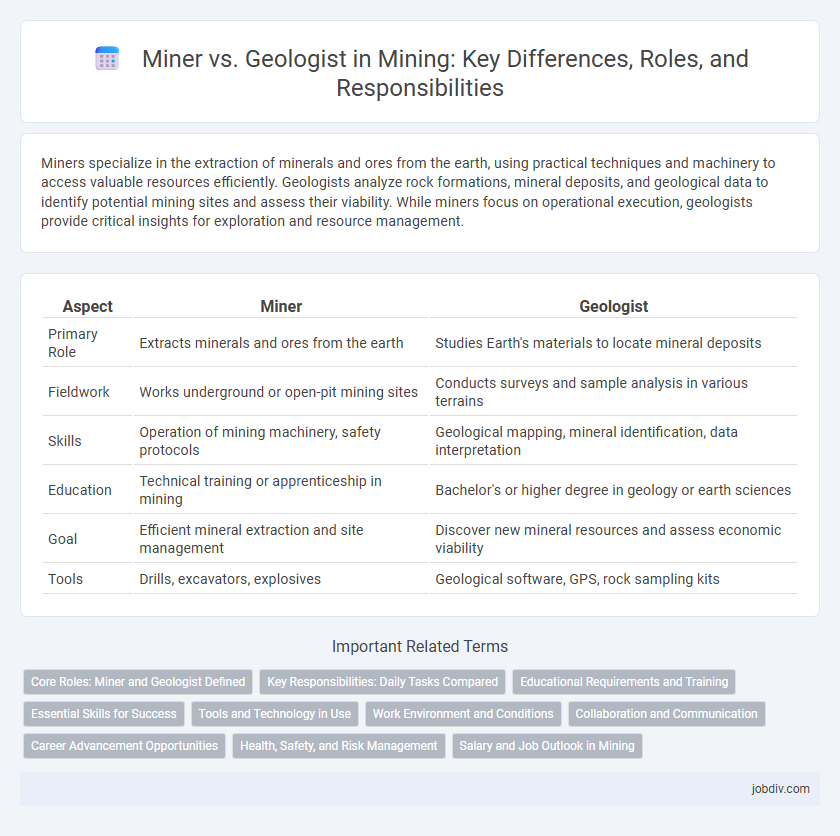Miners specialize in the extraction of minerals and ores from the earth, using practical techniques and machinery to access valuable resources efficiently. Geologists analyze rock formations, mineral deposits, and geological data to identify potential mining sites and assess their viability. While miners focus on operational execution, geologists provide critical insights for exploration and resource management.
Table of Comparison
| Aspect | Miner | Geologist |
|---|---|---|
| Primary Role | Extracts minerals and ores from the earth | Studies Earth's materials to locate mineral deposits |
| Fieldwork | Works underground or open-pit mining sites | Conducts surveys and sample analysis in various terrains |
| Skills | Operation of mining machinery, safety protocols | Geological mapping, mineral identification, data interpretation |
| Education | Technical training or apprenticeship in mining | Bachelor's or higher degree in geology or earth sciences |
| Goal | Efficient mineral extraction and site management | Discover new mineral resources and assess economic viability |
| Tools | Drills, excavators, explosives | Geological software, GPS, rock sampling kits |
Core Roles: Miner and Geologist Defined
Miners focus on extracting minerals and ores from the earth through physical labor and operation of heavy machinery in underground or surface mining environments. Geologists analyze the composition, structure, and processes of the earth's crust to locate mineral deposits and assess their quality and viability for extraction. Both professionals collaborate closely to ensure efficient resource recovery while maintaining safety and environmental standards.
Key Responsibilities: Daily Tasks Compared
Miners primarily focus on extracting minerals and ores from underground or surface mines using specialized equipment and techniques to ensure efficient and safe extraction processes. Geologists concentrate on studying rock formations, analyzing mineral content, and conducting field surveys to guide exploration and assess the viability of mining sites. While miners handle operational tasks such as drilling, blasting, and hauling, geologists provide critical data on mineral distribution, structural geology, and environmental impact to optimize mining strategies.
Educational Requirements and Training
Miners typically require a high school diploma or equivalent, with on-the-job training focused on operating mining equipment and safety protocols, while geologists demand advanced degrees in geology or earth sciences, often including a master's or PhD. Practical experience in fieldwork, data analysis, and mineral exploration is essential for geologists, who undergo specialized training in geological software and laboratory techniques. Miners benefit from certifications in equipment handling and safety, whereas geologists pursue research internships and professional licensure for career advancement.
Essential Skills for Success
Miners require physical stamina, technical proficiency in operating heavy machinery, and knowledge of safety protocols to extract minerals effectively. Geologists depend on strong analytical skills, expertise in rock formations, and proficiency in geological mapping software to identify mineral deposits accurately. Both professions benefit from teamwork and critical thinking to ensure successful mining operations.
Tools and Technology in Use
Miners primarily rely on heavy machinery such as drills, excavators, and loaders to extract minerals from the earth, incorporating technologies like GPS and automation for precision and safety. Geologists use advanced tools including ground-penetrating radar, seismic imaging, and geochemical sensors to analyze rock formations and identify mineral deposits with high accuracy. Both professions benefit from software such as GIS (Geographic Information Systems) and 3D modeling to optimize exploration and extraction processes.
Work Environment and Conditions
Miners work primarily underground or in open pits, facing physically demanding and hazardous conditions such as dust, noise, and confined spaces. Geologists operate mainly in field settings or offices, conducting site surveys and analyzing samples under variable weather but generally safer environments. Both professions require strict adherence to safety protocols, yet miners experience more direct exposure to operational risks.
Collaboration and Communication
Effective collaboration between miners and geologists enhances resource extraction by integrating practical mining methods with detailed geological data. Clear communication ensures accurate interpretation of geological surveys, optimizing mine planning and safety protocols. Regular information exchange supports adaptive decision-making, reducing operational risks and improving overall productivity.
Career Advancement Opportunities
Miners often advance through hands-on experience, gaining specialized certifications such as Heavy Equipment Operator or Blasting Technician, which open pathways to supervisory or safety management roles. Geologists progress by obtaining advanced degrees in Earth Sciences, enabling careers in exploration management, environmental consulting, or academia. Both careers benefit from continuous professional development, but geologists typically access broader leadership opportunities in research and strategic planning within the mining sector.
Health, Safety, and Risk Management
Miners face direct physical risks such as cave-ins, equipment accidents, and exposure to hazardous substances, necessitating rigorous safety protocols and protective gear to minimize injury and health issues like respiratory diseases. Geologists conduct site assessments to identify geological hazards and provide critical data that inform risk management strategies, enhancing mine safety and operational planning. Effective collaboration between miners and geologists ensures comprehensive hazard identification and implementation of preventive measures, significantly reducing workplace accidents and health risks.
Salary and Job Outlook in Mining
Miners typically earn an average salary ranging from $35,000 to $65,000 annually, influenced by experience and location, while geologists in the mining sector command higher earnings, often between $60,000 and $120,000 per year due to their specialized expertise. The job outlook for geologists remains strong, driven by ongoing demand for mineral exploration and environmental assessment, whereas miners face moderate growth prospects tied to industry automation and safety improvements. Both careers require knowledge of mining operations, but geologists benefit from broader opportunities in consulting, research, and environmental roles within the mining industry.
Miner vs Geologist Infographic

 jobdiv.com
jobdiv.com